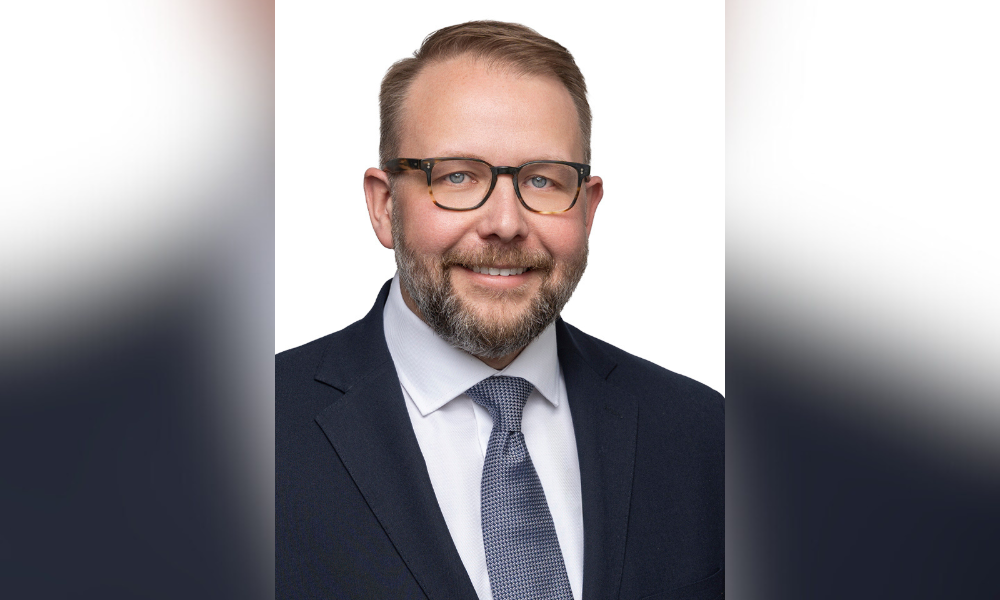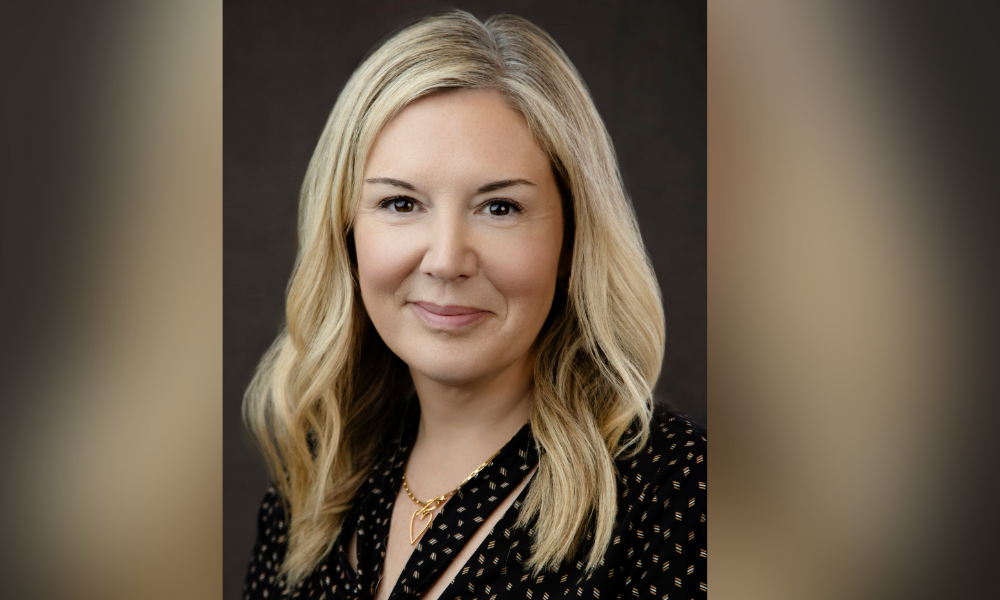The legal market is getting rough. “It’s Darwinian,” says Peter Griffin, managing partner of Lenczner Slaght Royce Smith Griffin LLP in Toronto. Blame it on any number of factors: the increased presence of US-based law firms in dealmaking; the erosion of senior relationships in favour of the request for proposal (RFP); general counsel being pressured by finance and procurement to cut legal spend; the commoditization of several areas of law or new legal technology.
The result is that larger firms are shifting their business models. They are tailoring their processes to the deal mandates that are available in Canada — often mid-market domestic acquisitions or working with firms based in the United States on multinational deals. While it is difficult to compare large and small firms without breaking down their practice areas, on an overall level, boutiques are finding their own routes to continued success, with models that work for them.
Small and focused, it turns out, might be a Darwinian answer to survival for boutiques.
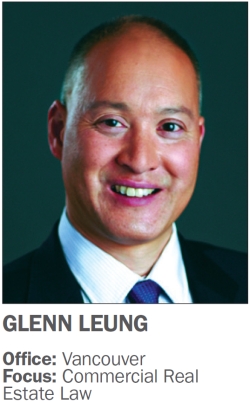 BUILD IT AND THEY WILL COME
BUILD IT AND THEY WILL COME
Glenn Leung
Terra Law Corp.
Glenn Leung and three fellow commercial real estate practitioners had been practising at a large national firm when, after 20-plus years there, they left to form Terra Law in 2013 with a clear strategy: to offer Vancouver’s red-hot commercial real estate market a dedicated boutique with “the same size and bench strength as a big-firm commercial real estate practice group.” Task one? Check. Today Terra has 12 commercial real estate lawyers, which is “as big as any big-firm real estate group in town,” says Leung, one of Terra’s founders.
Terra also decided to offer that same expertise at a lower cost. The move was welcomed by clients, he says, with many national law firms having jacked up their rates in the booming mid-2000s. When Terra was formed, the lawyers dropped their fees by 15 to 20 per cent across the board, says Leung, “so they were getting the same lawyers, the same bench strength, but for significantly less.” Terra also makes it a point to staff files leanly, generally with just one senior lawyer and one junior.
Did the strategy work? Of their clients at the big firm, “I’d say 90 per cent moved with us to the boutique venture and have stayed.”
Commercial real estate, unlike many other areas of law, involves a lot of repeat business. “If you have a bunch of developer clients you’ve worked with for 20 or 25 years, they do four, five or six projects a year kind of thing, so you get to know them really, really well,” Leung says. “The relationship is different than litigation or securities, for example. There’s way more integration with the client.”
The bottom line? “Our clients have been our champions in this thing. The clients were so happy that they went out and told people, and we got a lot of traction in this market. We’ve actually grown our market share.”
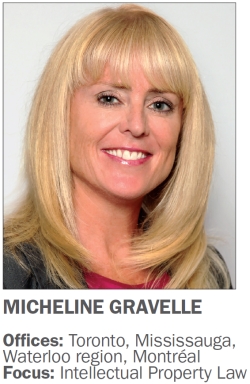 KEEPING THE INTELLECTUAL IN INTELLECTUAL PROPERTY
KEEPING THE INTELLECTUAL IN INTELLECTUAL PROPERTY
Micheline Gravelle
Bereskin & Parr LLP
With 73 lawyers, Bereskin & Parr is larger than many mid-size firms. But make no mistake, it’s actually a boutique. The firm practises only intellectual property law. Its strategy, consistent over the past 52 years, has been to hire really intelligent, well-educated people with the proper technical background to serve the clients, and keep them engaged.
“I think the depth we have in terms of our technical abilities just can’t be matched by the big firms,” says Micheline Gravelle, the boutique’s managing partner. “You go on our website and see all those degrees — you just don’t see that at most big firms. They may hire one PhD, but they don’t have the depth of people to train them.”
The firm has eight PhDs and six Master’s with law degrees just in their life-sciences practice group, “so we get excellent candidates who want to do the interesting work,” such as working directly with the inventors, writing and filing worldwide patent application, and remaining involved in their global strategy. A lot of big firms get incoming work — a patent that’s been drafted in the US that they’re asked to file in Canada, she says. But she doesn’t believe Bereskin & Parr would be able to keep the top people with that model. “We all love the science. We have engineers and scientists here who want to continue to use their first degrees.”
That firm’s natural competitors are other IP boutiques and big firms with large IP groups such as Gowling WLG and Borden Ladner Gervais LLP, she says. There is also competition coming from south of the border, with US IP firms coming to Canada to try to drum up business. “But we still hold our own.”
Gravelle says that, because Bereskin & Parr’s strategy revolves around “the smartest and best-educated people, associate retention is very important to us.” Associates are expected to bill 1,450 to 1,550 hours a year, less than many large firms. “A lot of firms talk about work-life balance. We offer it. It sounds odd, but maintaining our culture is really, really important to us. It just changes the work atmosphere. People work better when they’re happy.”
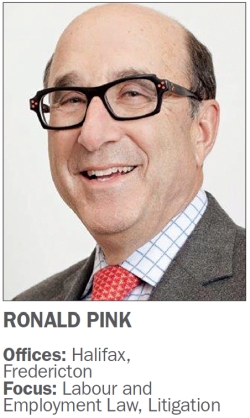 THE LABOUR OF ADAPTING
THE LABOUR OF ADAPTING
Ronald Pink
Pink Larkin LLP
Ronald Pink, managing partner of Pink Larkin LLP in Halifax, doesn’t see larger firms going after his boutique firm’s mandates — in fact, just the opposite. “We’re going after the work that goes to big firms,” says Pink, one of the founders of Pink Larkin in Halifax. The reason why is no mystery, he adds. “Clients are prepared to pay for expertise, but they don’t want to pay for bureaucracy.” His boutique firm, with 20 lawyers, gets requests to bid on the same work as the large Atlantic Canada firms “all the time, and we win our fair share of them because people see us as being practical, efficient, less costly and more nimble.”
That doesn’t mean his boutique doesn’t face its challenges. It does. Started 25 years ago as a pure employee-side labour and employment firm, that practice area once accounted for 100 per cent of its work. Today — with no growth in the trade union industry over the past five or 10 years — it accounts for less than 60 per cent of the firm’s mandates, Pink says. That’s where nimble comes in.
The strategy has been to specialize in certain areas of law that can “generally co-exist” with what they do. The firm does employer-side law for non-union situations. “We do a lot of employer work for trade unions, because they’re all employers too. The Canadian Union of Public Employees, for example, has 700 employees around the country.” They have also started to do a lot of pension and benefit work. “Pension and benefits all come out of employees, so we get to know actuarial firms, who say, ‘These guys are pretty capable,’ so we do some work for them. The boutique is also doing more professional regulation.
In what Pink Larkin sees as a statement move, it also recruited George MacDonald, one of Atlantic Canada’s pre-eminent litigators, when he bumped up against his former firm’s mandatory retirement age. He is not only freed of all the conflicts at his former firm, but many of his corporate clients have followed, says Pink. “So people see us as not just being a labour and employment boutique, but a skilled group of lawyers who do good work.”
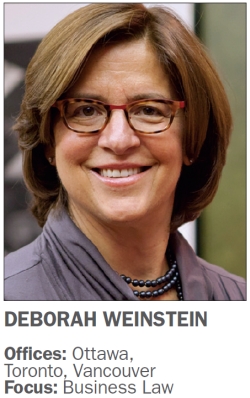 LASER BEAM FOCUS ON TECH
LASER BEAM FOCUS ON TECH
Deborah Weinstein
LaBarge Weinstein LLP
Deborah Weinstein is single-minded, you have to give her that. She co-founded her Ottawa-based boutique 20 years ago with the idea of focusing on the nexus of business law and high-technology companies and, even though the market around her has changed, LaBarge Weinstein hasn’t strayed, with 80 per cent of its business still coming from that one area. “When one looks at where technology was then and where it is now, it’s exploded,” she says. There have been at least three tech bubbles and busts, but “large firms cannot compete with our sustained focus right down the food chain to the earliest stage — and that really means the stage of the founders starting up.”
The firm, however, offers much more than start-up support. With 25 lawyers, LaBarge Weinstein provides knowledge-based companies, regardless of size, all the services they may need, from corporate and securities to tax, licensing and IP. Weinstein says there are only two big firms she sees regularly as potential competitors, “because they have a few partners that are focused on the technology industry. That’s key. The other law firms are focused on getting business clients. They’re not focused on marketing [to the tech industry].”
Not that they don’t try. Her competitors tend to use a couple of different strategies, she says, either spending a lot of money on branding and sponsorship at big industry-related events, or trying to dazzle a company that is suddenly becoming more visible. “With huge marketing machines and a huge marketing budget, they will throw hockey tickets at them, schmooze them, dine them, show them how great a firm they are to try to win their business.”
Although her firm is much smaller, its uses its lawyers to market in their hometowns and regions. “My Edmonton-born lawyer goes to the Alberta tech stuff, my New Brunswick-born lawyer handles the east coast, I’ve got a lawyer who handles Montréal, another Waterloo, three partners who tackle Atlantic Canada and six or eight in Toronto. So we’ll take clients from everywhere.”
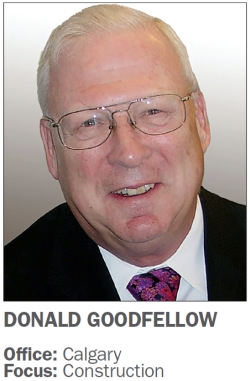 BUILDING EXPERTISE, NOT SIZE
BUILDING EXPERTISE, NOT SIZE
W. Donald Goodfellow
Whether it involves tendering, builders’ liens or other construction-related activities, when Donald Goodfellow sits down on a matter, there is almost always one or more large firms on the other side. With just four lawyers, he believes it’s essential that a tiny boutique like his has people that possess a deep well of knowledge and expertise in the one narrow area. “Many clients are now realizing that it is not the largeness of the firm that provides expertise but the knowledge within the firm.”
One of the particular challenges a small boutique faces, he says, is “dealing with big firms that have sophisticated computers and IT systems, etc.” No matter how small the law firm, if you want to play in the big leagues, Goodfellow says it is “essential” to have the same IT, technology and expertise the large and mid-size law firms have. His lawyers use software for case management, practice management, matter management and process management, and are currently “dealing with lawsuits where there are tens of thousands of documents.” He says his tiny firm can use these systems, and other technologies, to match “and I dare say out-do” some of the larger law firms that represent opposing parties.
Being small also has its advantages. One is that boutiques usually do not have to have a mandatory retirement age that forces senior partners out. “This, I think, is one of the downsides of large firms,” he says. “As senior partners grow older, they realize that, once they reach 62 or 65 years of age, they are going to be out the door notwithstanding that they may be in the best years of knowledge and service to both their clients and the firm.”
At the end of the day, he says, the best strategy for successfully competing as a boutique is “strictly reputation,” which means having the best lawyers, some of them older big-firm refugees. That’s because a lot of the construction companies have come to the conclusion that “it’s best to find out who is the leader in the industry and use that person,” regardless of where they work.
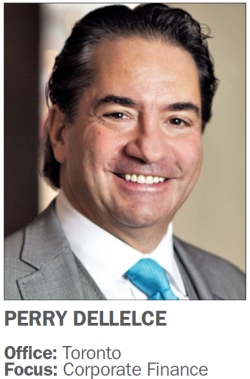 GROWING UP WITH YOUR CLIENTS
GROWING UP WITH YOUR CLIENTS
Perry Dellelce
Wildeboer Dellelce LLP
When five partners left Stikeman Elliot LLP to set up Wildeboer Dellelce as a standalone corporate-finance boutique in 1993, Bay Street must have thought they were crazy, says Perry Dellelce, the boutique’s managing partner. “We knew we weren’t going to take Air Canada, CIBC, Nortel or Bombardier with us. But we knew we didn’t leave our brains behind.”
After that, he says, “it was just contacts and hustle, and it worked.” The young boutique played to the entrepreneur class and did things like dress casually long before casual Fridays became vogue. It also did equity for fees, “or what we now call alternative fee arrangements, long before Silicon Valley made it hip to do. We were less bureaucratic and more flexible right from the very beginning and that really led to a bond with entrepreneurs.”
From 1993 to 2001, all of the firm’s entrepreneurs were practising technology law. When the tech bubble burst, “the music stopped and we didn’t have a chair. We were cut in half.” Wildeboer Dellelce decided to expand beyond straight corporate financings into areas such as lending, real estate, investment funds, mutual funds and structured products, “which is all part of the same thing — it’s all corporate finance. If you took our group and put it into a large firm, we’d be a big corporate finance group.”
Today, with 35 lawyers, the way Wildeboer Dellelce competes against larger competing law firms is by keeping their billable rate on day-to-day matters 20 to 30 per cent lower than the big firms charge, “and we can afford to do that because our infrastructure is less.” On large transformational deals and high-risk, time-sensitive matters, Dellelce says, they still bill the same as large firms.
As for their core strategy, it is focused on relationships. Large firms are better positioned to take on mid-sized deals now. However, Dellelce says that “we’ve grown up with a lot of these companies. We have very strong personal and business relationships with them. We can and do continue to service them in good times and in bad.”
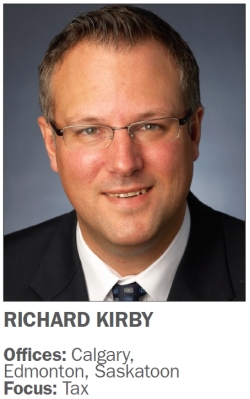 CREATIVITY OVER SPREADSHEETS
CREATIVITY OVER SPREADSHEETS
Richard Kirby
Felesky Flynn LLP
Young lawyers who are interested in tax and want to work at a large firm also often get stuck working on a real estate file or doing securities work as part of their training. Not at Felesky Flynn, a 40-lawyer tax boutique. It’s all tax, all the time, right from day one, “which makes us the top choice for somebody who only wants to practise tax,” says Richard Kirby, managing partner of the boutique’s Edmonton office.
Big, mid-size and regional firms are all Felesky Flynn’s natural competitors for tax work. Does he worry? Nah. “The shining stars of those firms are the securities lawyers. I think tax lawyers, especially in the big firms, are not given the recognition they deserve because they’re not looked at as real profit centres. What they are seen as is service providers to their securities groups and their M&A groups.”
The large firms are built to work on large matters where they can charge by the hour and put a lot of bodies on file, Kirby says. Tax doesn’t use much leverage. A lot of the brilliant tax practitioners are not client-facing, but they bring “huge value by coming up with ideas. Those people don’t get recognized in the big firms because they don’t show revenue on their spreadsheet. They’re brilliant, they may come up with great ideas, but they’re not valued properly because firms just want to know how many hours they’ve billed and how many bodies they’ve kept busy.”
That even trickles down to compensation, he says. “In the big firms, who gets compensated the most? The securities and M&A guys.” How does Felesky Flynn’s compensation levels compare? “Our compensation would probably be higher, or on par with a big-firm superstar tax practitioner.” Still, the main strategy for gaining work is finding people who are jazzed about tax “then giving them lots of time to think about creative options for their clients.
“Tax is as much an art as it is a science. We value creativity over spreadsheets; we’re probably a hybrid between a law firm and academia. We really value the creative process — and those are hours that don’t land on the timesheet. That’s very hard to do at a big firm.”
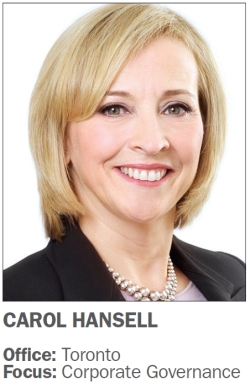 TECHNOLOGY WILL NEVER REPLACE JUDGMENT
TECHNOLOGY WILL NEVER REPLACE JUDGMENT
Carol Hansell
Hansell LLP
Carol Hansell already had a top name in corporate governance when she left her longtime corporate law firm in 2013 to form her own governance-based boutique, Hansell LLP. That makes natural competitors for her five-lawyer boutique just about every other large and mid-sized law firm out there. “When it comes to corporate lawyers, everybody deals with governance to some extent,” says Hansell.
With law being commoditized, it’s driving prices lower so boutiques like hers can’t compete on price alone — and she is far too pragmatic to try. “We’re very careful with our pricing but when it comes to judgment-based advice, technology won’t ever overwhelm that. I guess the message at the end of the day is, getting judgment-based advice from somebody whose judgment you want will never go out of style. We’re not anybody’s regular law firm. They come to use for very specific advice at a senior level.”
People may go to Hansell for that highly governance-focused expertise, but sometimes they get more than they bargained for — in a good way. Her boutique also includes non-legal analysts, government-relations people and crisis communications consultants. There are many excellent external crisis communications and government-relations experts, she says, that don’t work within a law firm. And most law firms are strictly law.
“Our idea is that the clients are looking for integrated advice, but if I say to a client, ‘I think we need communications advice, so I’m going to hire a consultant,’ often they’d say, ‘Hmmm.’ But if we can just provide the communications advice, or have a government-relations person step into the meeting to say, ‘This is what this looks like,’ we’re not going through a whole separate vetting process, [requests for proposals] and all that. There’s a lot of complication to hiring other advisors versus having them in-house.”
Also, Hansell points out that an integrated team is more likely to talk openly and work co-operatively “because if you’re siloed, everybody wants to win the point, because that’s how they’re relevant.” That’s just the kind of advice technology will never offer.
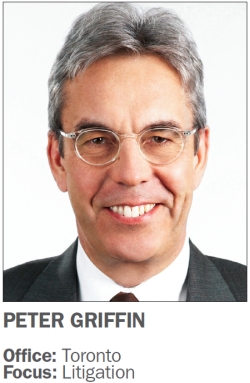 MINDFUL COMPETITION
MINDFUL COMPETITION
Peter Griffin
Lenczner Slaght Royce Smith Griffin LLP
When it comes to Bay Street litigation boutiques, Lenczner Slaght is unquestionably among the most prominent. With 57 lawyers, it is equal in size and mandate to large firm litigation departments. It is also a go-to firm for big-firm conflict work, a delicate dance where top corporate firms are sometimes friends, and sometimes foes.
Managing partner Peter Griffin says if Lenczner Slaght gets a call from a large corporation asking it to handle a litigation matter, the firm will accept it regardless of the client’s existing relationships with other firms. But Lenczner Slaght is also “mindful” that referrals from the top-tier corporate firms are an important source of work, so it is very careful to be “respectful.” That means it won’t try to poach a file by calling another firm’s client who may be facing a disclosure issue, for example, to try to convince them to let the boutique do any resulting class-action litigation.
Where Lenczner does get referrals, it is careful to keep the partner who sent the work in the loop as much as possible, without violating client confidentiality, “so they know what’s going on, the key developments, and when it’s over.” They then send the client back to the referring firm as soon as possible.
They also, incidentally, try to do great work. “I know if I send somebody somewhere, it’s because I want a good job done. I want to know at the end of the day that the client says, ‘Thanks for sending me to XY or Z because they did a great job.’ Then I know the client’s interests are protected. So I’m very mindful that they put their credibility on the line when they make a recommendation.”
It’s one thing to be on top, another to stay there. Lenczner’s strategy is to keep an eye on diversification into areas that make sense. “We have, for instance, a growing intellectual property litigation practice,” Griffin says. “You’ve got to look at the marketplace and where you can fit — and fit well, given our size and profile. Going head to head just on commercial litigation, there’s only a certain amount of it. You run into the Darwinian principle, more people fighting for less work. So we’re constantly on the lookout now for areas of diversification.”
Sandra Rubin is a Toronto-based writer and strategic consultant.
The result is that larger firms are shifting their business models. They are tailoring their processes to the deal mandates that are available in Canada — often mid-market domestic acquisitions or working with firms based in the United States on multinational deals. While it is difficult to compare large and small firms without breaking down their practice areas, on an overall level, boutiques are finding their own routes to continued success, with models that work for them.
Small and focused, it turns out, might be a Darwinian answer to survival for boutiques.
 BUILD IT AND THEY WILL COME
BUILD IT AND THEY WILL COMEGlenn Leung
Terra Law Corp.
Glenn Leung and three fellow commercial real estate practitioners had been practising at a large national firm when, after 20-plus years there, they left to form Terra Law in 2013 with a clear strategy: to offer Vancouver’s red-hot commercial real estate market a dedicated boutique with “the same size and bench strength as a big-firm commercial real estate practice group.” Task one? Check. Today Terra has 12 commercial real estate lawyers, which is “as big as any big-firm real estate group in town,” says Leung, one of Terra’s founders.
Terra also decided to offer that same expertise at a lower cost. The move was welcomed by clients, he says, with many national law firms having jacked up their rates in the booming mid-2000s. When Terra was formed, the lawyers dropped their fees by 15 to 20 per cent across the board, says Leung, “so they were getting the same lawyers, the same bench strength, but for significantly less.” Terra also makes it a point to staff files leanly, generally with just one senior lawyer and one junior.
Did the strategy work? Of their clients at the big firm, “I’d say 90 per cent moved with us to the boutique venture and have stayed.”
Commercial real estate, unlike many other areas of law, involves a lot of repeat business. “If you have a bunch of developer clients you’ve worked with for 20 or 25 years, they do four, five or six projects a year kind of thing, so you get to know them really, really well,” Leung says. “The relationship is different than litigation or securities, for example. There’s way more integration with the client.”
The bottom line? “Our clients have been our champions in this thing. The clients were so happy that they went out and told people, and we got a lot of traction in this market. We’ve actually grown our market share.”
 KEEPING THE INTELLECTUAL IN INTELLECTUAL PROPERTY
KEEPING THE INTELLECTUAL IN INTELLECTUAL PROPERTYMicheline Gravelle
Bereskin & Parr LLP
With 73 lawyers, Bereskin & Parr is larger than many mid-size firms. But make no mistake, it’s actually a boutique. The firm practises only intellectual property law. Its strategy, consistent over the past 52 years, has been to hire really intelligent, well-educated people with the proper technical background to serve the clients, and keep them engaged.
“I think the depth we have in terms of our technical abilities just can’t be matched by the big firms,” says Micheline Gravelle, the boutique’s managing partner. “You go on our website and see all those degrees — you just don’t see that at most big firms. They may hire one PhD, but they don’t have the depth of people to train them.”
The firm has eight PhDs and six Master’s with law degrees just in their life-sciences practice group, “so we get excellent candidates who want to do the interesting work,” such as working directly with the inventors, writing and filing worldwide patent application, and remaining involved in their global strategy. A lot of big firms get incoming work — a patent that’s been drafted in the US that they’re asked to file in Canada, she says. But she doesn’t believe Bereskin & Parr would be able to keep the top people with that model. “We all love the science. We have engineers and scientists here who want to continue to use their first degrees.”
That firm’s natural competitors are other IP boutiques and big firms with large IP groups such as Gowling WLG and Borden Ladner Gervais LLP, she says. There is also competition coming from south of the border, with US IP firms coming to Canada to try to drum up business. “But we still hold our own.”
Gravelle says that, because Bereskin & Parr’s strategy revolves around “the smartest and best-educated people, associate retention is very important to us.” Associates are expected to bill 1,450 to 1,550 hours a year, less than many large firms. “A lot of firms talk about work-life balance. We offer it. It sounds odd, but maintaining our culture is really, really important to us. It just changes the work atmosphere. People work better when they’re happy.”
 THE LABOUR OF ADAPTING
THE LABOUR OF ADAPTINGRonald Pink
Pink Larkin LLP
Ronald Pink, managing partner of Pink Larkin LLP in Halifax, doesn’t see larger firms going after his boutique firm’s mandates — in fact, just the opposite. “We’re going after the work that goes to big firms,” says Pink, one of the founders of Pink Larkin in Halifax. The reason why is no mystery, he adds. “Clients are prepared to pay for expertise, but they don’t want to pay for bureaucracy.” His boutique firm, with 20 lawyers, gets requests to bid on the same work as the large Atlantic Canada firms “all the time, and we win our fair share of them because people see us as being practical, efficient, less costly and more nimble.”
That doesn’t mean his boutique doesn’t face its challenges. It does. Started 25 years ago as a pure employee-side labour and employment firm, that practice area once accounted for 100 per cent of its work. Today — with no growth in the trade union industry over the past five or 10 years — it accounts for less than 60 per cent of the firm’s mandates, Pink says. That’s where nimble comes in.
The strategy has been to specialize in certain areas of law that can “generally co-exist” with what they do. The firm does employer-side law for non-union situations. “We do a lot of employer work for trade unions, because they’re all employers too. The Canadian Union of Public Employees, for example, has 700 employees around the country.” They have also started to do a lot of pension and benefit work. “Pension and benefits all come out of employees, so we get to know actuarial firms, who say, ‘These guys are pretty capable,’ so we do some work for them. The boutique is also doing more professional regulation.
In what Pink Larkin sees as a statement move, it also recruited George MacDonald, one of Atlantic Canada’s pre-eminent litigators, when he bumped up against his former firm’s mandatory retirement age. He is not only freed of all the conflicts at his former firm, but many of his corporate clients have followed, says Pink. “So people see us as not just being a labour and employment boutique, but a skilled group of lawyers who do good work.”
 LASER BEAM FOCUS ON TECH
LASER BEAM FOCUS ON TECHDeborah Weinstein
LaBarge Weinstein LLP
Deborah Weinstein is single-minded, you have to give her that. She co-founded her Ottawa-based boutique 20 years ago with the idea of focusing on the nexus of business law and high-technology companies and, even though the market around her has changed, LaBarge Weinstein hasn’t strayed, with 80 per cent of its business still coming from that one area. “When one looks at where technology was then and where it is now, it’s exploded,” she says. There have been at least three tech bubbles and busts, but “large firms cannot compete with our sustained focus right down the food chain to the earliest stage — and that really means the stage of the founders starting up.”
The firm, however, offers much more than start-up support. With 25 lawyers, LaBarge Weinstein provides knowledge-based companies, regardless of size, all the services they may need, from corporate and securities to tax, licensing and IP. Weinstein says there are only two big firms she sees regularly as potential competitors, “because they have a few partners that are focused on the technology industry. That’s key. The other law firms are focused on getting business clients. They’re not focused on marketing [to the tech industry].”
Not that they don’t try. Her competitors tend to use a couple of different strategies, she says, either spending a lot of money on branding and sponsorship at big industry-related events, or trying to dazzle a company that is suddenly becoming more visible. “With huge marketing machines and a huge marketing budget, they will throw hockey tickets at them, schmooze them, dine them, show them how great a firm they are to try to win their business.”
Although her firm is much smaller, its uses its lawyers to market in their hometowns and regions. “My Edmonton-born lawyer goes to the Alberta tech stuff, my New Brunswick-born lawyer handles the east coast, I’ve got a lawyer who handles Montréal, another Waterloo, three partners who tackle Atlantic Canada and six or eight in Toronto. So we’ll take clients from everywhere.”
 BUILDING EXPERTISE, NOT SIZE
BUILDING EXPERTISE, NOT SIZEW. Donald Goodfellow
Whether it involves tendering, builders’ liens or other construction-related activities, when Donald Goodfellow sits down on a matter, there is almost always one or more large firms on the other side. With just four lawyers, he believes it’s essential that a tiny boutique like his has people that possess a deep well of knowledge and expertise in the one narrow area. “Many clients are now realizing that it is not the largeness of the firm that provides expertise but the knowledge within the firm.”
One of the particular challenges a small boutique faces, he says, is “dealing with big firms that have sophisticated computers and IT systems, etc.” No matter how small the law firm, if you want to play in the big leagues, Goodfellow says it is “essential” to have the same IT, technology and expertise the large and mid-size law firms have. His lawyers use software for case management, practice management, matter management and process management, and are currently “dealing with lawsuits where there are tens of thousands of documents.” He says his tiny firm can use these systems, and other technologies, to match “and I dare say out-do” some of the larger law firms that represent opposing parties.
Being small also has its advantages. One is that boutiques usually do not have to have a mandatory retirement age that forces senior partners out. “This, I think, is one of the downsides of large firms,” he says. “As senior partners grow older, they realize that, once they reach 62 or 65 years of age, they are going to be out the door notwithstanding that they may be in the best years of knowledge and service to both their clients and the firm.”
At the end of the day, he says, the best strategy for successfully competing as a boutique is “strictly reputation,” which means having the best lawyers, some of them older big-firm refugees. That’s because a lot of the construction companies have come to the conclusion that “it’s best to find out who is the leader in the industry and use that person,” regardless of where they work.
 GROWING UP WITH YOUR CLIENTS
GROWING UP WITH YOUR CLIENTSPerry Dellelce
Wildeboer Dellelce LLP
When five partners left Stikeman Elliot LLP to set up Wildeboer Dellelce as a standalone corporate-finance boutique in 1993, Bay Street must have thought they were crazy, says Perry Dellelce, the boutique’s managing partner. “We knew we weren’t going to take Air Canada, CIBC, Nortel or Bombardier with us. But we knew we didn’t leave our brains behind.”
After that, he says, “it was just contacts and hustle, and it worked.” The young boutique played to the entrepreneur class and did things like dress casually long before casual Fridays became vogue. It also did equity for fees, “or what we now call alternative fee arrangements, long before Silicon Valley made it hip to do. We were less bureaucratic and more flexible right from the very beginning and that really led to a bond with entrepreneurs.”
From 1993 to 2001, all of the firm’s entrepreneurs were practising technology law. When the tech bubble burst, “the music stopped and we didn’t have a chair. We were cut in half.” Wildeboer Dellelce decided to expand beyond straight corporate financings into areas such as lending, real estate, investment funds, mutual funds and structured products, “which is all part of the same thing — it’s all corporate finance. If you took our group and put it into a large firm, we’d be a big corporate finance group.”
Today, with 35 lawyers, the way Wildeboer Dellelce competes against larger competing law firms is by keeping their billable rate on day-to-day matters 20 to 30 per cent lower than the big firms charge, “and we can afford to do that because our infrastructure is less.” On large transformational deals and high-risk, time-sensitive matters, Dellelce says, they still bill the same as large firms.
As for their core strategy, it is focused on relationships. Large firms are better positioned to take on mid-sized deals now. However, Dellelce says that “we’ve grown up with a lot of these companies. We have very strong personal and business relationships with them. We can and do continue to service them in good times and in bad.”
 CREATIVITY OVER SPREADSHEETS
CREATIVITY OVER SPREADSHEETSRichard Kirby
Felesky Flynn LLP
Young lawyers who are interested in tax and want to work at a large firm also often get stuck working on a real estate file or doing securities work as part of their training. Not at Felesky Flynn, a 40-lawyer tax boutique. It’s all tax, all the time, right from day one, “which makes us the top choice for somebody who only wants to practise tax,” says Richard Kirby, managing partner of the boutique’s Edmonton office.
Big, mid-size and regional firms are all Felesky Flynn’s natural competitors for tax work. Does he worry? Nah. “The shining stars of those firms are the securities lawyers. I think tax lawyers, especially in the big firms, are not given the recognition they deserve because they’re not looked at as real profit centres. What they are seen as is service providers to their securities groups and their M&A groups.”
The large firms are built to work on large matters where they can charge by the hour and put a lot of bodies on file, Kirby says. Tax doesn’t use much leverage. A lot of the brilliant tax practitioners are not client-facing, but they bring “huge value by coming up with ideas. Those people don’t get recognized in the big firms because they don’t show revenue on their spreadsheet. They’re brilliant, they may come up with great ideas, but they’re not valued properly because firms just want to know how many hours they’ve billed and how many bodies they’ve kept busy.”
That even trickles down to compensation, he says. “In the big firms, who gets compensated the most? The securities and M&A guys.” How does Felesky Flynn’s compensation levels compare? “Our compensation would probably be higher, or on par with a big-firm superstar tax practitioner.” Still, the main strategy for gaining work is finding people who are jazzed about tax “then giving them lots of time to think about creative options for their clients.
“Tax is as much an art as it is a science. We value creativity over spreadsheets; we’re probably a hybrid between a law firm and academia. We really value the creative process — and those are hours that don’t land on the timesheet. That’s very hard to do at a big firm.”
 TECHNOLOGY WILL NEVER REPLACE JUDGMENT
TECHNOLOGY WILL NEVER REPLACE JUDGMENTCarol Hansell
Hansell LLP
Carol Hansell already had a top name in corporate governance when she left her longtime corporate law firm in 2013 to form her own governance-based boutique, Hansell LLP. That makes natural competitors for her five-lawyer boutique just about every other large and mid-sized law firm out there. “When it comes to corporate lawyers, everybody deals with governance to some extent,” says Hansell.
With law being commoditized, it’s driving prices lower so boutiques like hers can’t compete on price alone — and she is far too pragmatic to try. “We’re very careful with our pricing but when it comes to judgment-based advice, technology won’t ever overwhelm that. I guess the message at the end of the day is, getting judgment-based advice from somebody whose judgment you want will never go out of style. We’re not anybody’s regular law firm. They come to use for very specific advice at a senior level.”
People may go to Hansell for that highly governance-focused expertise, but sometimes they get more than they bargained for — in a good way. Her boutique also includes non-legal analysts, government-relations people and crisis communications consultants. There are many excellent external crisis communications and government-relations experts, she says, that don’t work within a law firm. And most law firms are strictly law.
“Our idea is that the clients are looking for integrated advice, but if I say to a client, ‘I think we need communications advice, so I’m going to hire a consultant,’ often they’d say, ‘Hmmm.’ But if we can just provide the communications advice, or have a government-relations person step into the meeting to say, ‘This is what this looks like,’ we’re not going through a whole separate vetting process, [requests for proposals] and all that. There’s a lot of complication to hiring other advisors versus having them in-house.”
Also, Hansell points out that an integrated team is more likely to talk openly and work co-operatively “because if you’re siloed, everybody wants to win the point, because that’s how they’re relevant.” That’s just the kind of advice technology will never offer.
 MINDFUL COMPETITION
MINDFUL COMPETITIONPeter Griffin
Lenczner Slaght Royce Smith Griffin LLP
When it comes to Bay Street litigation boutiques, Lenczner Slaght is unquestionably among the most prominent. With 57 lawyers, it is equal in size and mandate to large firm litigation departments. It is also a go-to firm for big-firm conflict work, a delicate dance where top corporate firms are sometimes friends, and sometimes foes.
Managing partner Peter Griffin says if Lenczner Slaght gets a call from a large corporation asking it to handle a litigation matter, the firm will accept it regardless of the client’s existing relationships with other firms. But Lenczner Slaght is also “mindful” that referrals from the top-tier corporate firms are an important source of work, so it is very careful to be “respectful.” That means it won’t try to poach a file by calling another firm’s client who may be facing a disclosure issue, for example, to try to convince them to let the boutique do any resulting class-action litigation.
Where Lenczner does get referrals, it is careful to keep the partner who sent the work in the loop as much as possible, without violating client confidentiality, “so they know what’s going on, the key developments, and when it’s over.” They then send the client back to the referring firm as soon as possible.
They also, incidentally, try to do great work. “I know if I send somebody somewhere, it’s because I want a good job done. I want to know at the end of the day that the client says, ‘Thanks for sending me to XY or Z because they did a great job.’ Then I know the client’s interests are protected. So I’m very mindful that they put their credibility on the line when they make a recommendation.”
It’s one thing to be on top, another to stay there. Lenczner’s strategy is to keep an eye on diversification into areas that make sense. “We have, for instance, a growing intellectual property litigation practice,” Griffin says. “You’ve got to look at the marketplace and where you can fit — and fit well, given our size and profile. Going head to head just on commercial litigation, there’s only a certain amount of it. You run into the Darwinian principle, more people fighting for less work. So we’re constantly on the lookout now for areas of diversification.”
Sandra Rubin is a Toronto-based writer and strategic consultant.
Lawyer(s)
B. Glenn Leung
Micheline Gravelle
W. Donald Goodfellow
Perry N. Dellelce
Carol Hansell
Peter Griffin




